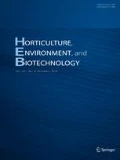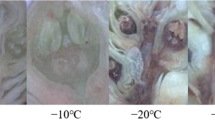Abstract
There is increasing interest in expanding grapevine production into colder regions. Here, to identify reliable methods for evaluating cold hardiness, we analyzed tissue discoloration, electrolyte leakage (EL), triphenyl tetrazolium chloride (TTC) reduction, and exotherms in the buds and canes of ‘Campbell Early’ grapevines. In both tissues, we monitored exotherms during cooling to − 40 °C at a rate of − 2 °C/h and analyzed the other indices during 2-h exposure to various freezing temperatures. Evaluating tissue discoloration is a subjective method to score freezing injury; it is more time-consuming and requires larger amounts of sample material than other methods but offers the advantage that it can be used to estimate LT50 (the temperature at which 50% injury occurs). EL analysis in buds and canes is another relatively rapid technique providing reproducible LT50 values. However, our EL analysis of buds was limited by the small amounts of sample material. For TTC reduction analysis, the results were not reproducible for both buds and canes: at the same freezing temperature, buds and canes showed significant differences in TTC reduction levels, leading to erroneous LT50 estimates. Finally, detection of low-temperature exotherms (LTEs), an indicator of intracellular ice formation (which causes fatal cell damage), through differential thermal analysis revealed LTEs in buds but seldom in canes, and those detected in buds exhibited much narrower peaks. Thus, exotherm and EL analyses are reliable methods for evaluating cold hardiness of grapevine buds and canes, respectively, and their combined application could be a useful strategy for assessing grapevine cultivars.






Similar content being viewed by others
References
Antivilo FG, Paz RC, Tognetti J, Keller M, Cavagnaro M, Barrio EE, Juñent FR (2020) Winter injury to grapevine secondary phloem and cambium impairs budbreak, cambium activity, and yield formation. J Plant Growth Regul 39:1095–1106. https://doi.org/10.1007/s00344-019-10051-w
Arora R (2018) Mechanism of freeze-thaw injury and recovery: a cool retrospective and warming up to new ideas. Plant Sci 270:301–313. https://doi.org/10.1016/j.plantsci.2018.03.002
Arora R, Wisniewski ME, Scorza R (1992) Cold acclimation in genetically related (sibling) deciduous and evergreen peach (Prunus persica [L.] Batsch). 1. Seasonal changes in cold hardiness and polypeptides of bark and xylem tissues. Plant Physiol 99:1562–1568. https://doi.org/10.1104/pp.99.4.1562
Ashworth EN, Echlin P, Pearce RS, Hayes TL (1988) Ice formation and tissue response in apple twigs. Plant Cell Environ 11:703–710. https://doi.org/10.1111/j.1365-3040.1988.tb01153.x
Aslamarz AA, Vhdati K, Hassani D, Rahemi M, Mohammadi N, Leslie C (2011) Cold hardiness and its relationship with proline content in Persian walnut. Eur J Hortic Sci 76:84–90
Busso C, Torres Y, Ithurrart L, Richards JH (2015) The TTC-technique might not appropriately test the physiological stage of plant tissues. Russ J Plant Physiol 62:551–556. https://doi.org/10.1134/S1021443715040068
Grant TNL, Dami IE (2015) Physiological and biochemical seasonal changes in Vitis genotypes with contrasting freezing tolerance. Am J Enol Vitic 66:195–203. https://doi.org/10.5344/ajev.2014.14101
Kaya Ö, Köse C (2017) Determination of resistance to low temperatures of winter buds on lateral shoot present in Karaerik (Vitis vinifera L.) grape cultivar. Acta Physiol Plant 39:209. https://doi.org/10.1007/s11738-017-2513-7
Kim M, Yun SK, Kim SS, Park Y, Joa J, Han S, Shin K, Song KJ (2021) Response of citrus to freezing tolerance differs depending on genotypes and growing conditions. Hortic Environ Biotechnol 62:181–189. https://doi.org/10.1007/s13580-020-00311-0
Kishimoto T, Yamazaki H, Saruwatari A, Murakawa H, Sekozawa Y, Kuchitsu K, Price WS, Ishikawa M (2014) High ice nucleation activity located in blueberry stem bark is linked to primary freeze initiation and adaptive freezing behavior of the bark. AoB Plants 6:044. https://doi.org/10.1093/aobpla/plu044
Lakon G (1949) The topographical tetrazolium method for determining the germinating capacity of seeds. Plant Physiol 24:389–394. https://doi.org/10.1104/pp.24.3.389
Lee JH, Yu DJ, Kim SJ, Choi D, Lee HJ (2012) Intraspecies differences in cold hardiness, carbohydrate content, and β-amylase gene expression of Vaccinium corymbosum during cold acclimation and deacclimation. Tree Physiol 32:1533–1540. https://doi.org/10.1093/treephys/tps102
Lee JI, Yu DJ, Lee JH, Kim SJ, Lee HJ (2013) Comparison of mid-winter cold-hardiness and soluble sugars contents in the shoots of 21 highbush blueberry (Vaccinium corymbosum) cultivars. J Hortic Sci Biotechnol 88:727–734. https://doi.org/10.1080/14620316.2013.11513031
Lenz A, Hoch G, Vitasse Y (2016) Fast acclimation of freezing resistance suggests no influence of winter minimum temperature on the range limit of European beech. Tree Physiol 36:490–501. https://doi.org/10.1093/treephys/tpv147
Lim CC, Arora R, Townsend EC (1998) Comparing Gompertz and Richards functions to estimate freezing injury in Rhododendron using electrolyte leakage. J Am Soc Hortic Sci 123:246–252. https://doi.org/10.21273/JASHS.123.2.246
Liu J, Lindstrom OM, Chavez DJ (2019) Differential thermal analysis of ‘Elberta’ and ‘Flavorich’ peach flower buds to predict cold hardiness in Georgia. HortScience 54:676–683. https://doi.org/10.21273/HORTSCI13518-18
London JP, Kovaleski AP (2017) Characterization of wild North American grapevine cold hardiness using differential thermal analysis. Am J Enol Vitic 68:203–212. https://doi.org/10.5344/ajev.2016.16090
Lopez del Egido L, Navarro-Miró D, Martinez-Heredia V, Toorop PE, Iannetta PPM (2017) A spectrophotometric assay for robust viability testing of seed batches using 2,3,5-triphenyl tetrazolium chloride: using Hordeum vulgare L. as a model. Front Plant Sci 8:747. https://doi.org/10.3389/fpls.2017.00747
Mills LJ, Ferguson JC, Keller M (2006) Cold-hardiness evaluation of grapevine buds and cane tissues. Am J Enol Vitic 57:194–200
Moran RE, Sun Y, Geng F, Zhang D, Fazio G (2011) Cold temperature tolerance of trunk and root tissues in one- and two-year-old apple rootstocks. HortScience 46:1460–1464. https://doi.org/10.21273/HORTSCI.46.11.1460
Nesbitt ML, Ebel RC, Findley D, Wilkins B, Woods F, Himelrick D (2002) Assays to assess freeze injury of satsuma mandarin. HortScience 37:871–877. https://doi.org/10.21273/HORTSCI.37.6.871
Neuner G, Monitzer K, Kaplenig D, Ingruber J (2019) Frost survival mechanism of vegetative buds in temperate trees: deep supercooling and extraorgan freezing vs ice tolerance. Front Plant Sci 10:537. https://doi.org/10.3389/fpls.2019.00537
Neuner G, Xu B, Hacker J (2010) Velocity and pattern of ice propagation and deep supercooling in woody stems of Castanea sativa, Morus nigra, and Quercus robur measured by IDTA. Tree Physiol 30:1037–1045. https://doi.org/10.1093/treephys/tpq059
Pagter M, Arora R (2013) Winter survival and deacclimation of perennials under warming climate: physiological perspectives. Physiol Plant 147:75–87. https://doi.org/10.1111/j.1399-3054.2012.01650.x
Pearce RS (2001) Plant freezing and damage. Ann Bot 87:417–424. https://doi.org/10.1006/anbo.2000.1352
Pramsohler M, Hacker J, Neuner G (2012) Freezing pattern and frost killing temperature of apple (Malus domestica) wood under controlled conditions and in nature. Tree Physiol 32:819–828. https://doi.org/10.1093/treephys/tps046
Quamme HA (1991) Application of thermal analysis to breeding fruit crops for increased cold hardiness. HortScience 26:513–517. https://doi.org/10.21273/HORTSCI.26.5.513
Rouet-Mayer MA, Ralambosoa J, Philippon J (1990) Roles of o-quinones and their polymers in the enzymic browning of apples. Phytochemistry 29:435–440. https://doi.org/10.1016/0031-9422(90)85092-T
Ruf M, Brunner I (2003) Vitality of tree fine roots: reevaluation of the tetrazolium test. Tree Physiol 23:257–263. https://doi.org/10.1093/treephys/23.4.257
Salazar-Gutiérrez MR, Chaves B, Anothai J, Whiting M, Hoogenboom G (2014) Variation in cold hardiness of sweet cherry flower buds through different phenological stages. Sci Hortic 172:161–167. https://doi.org/10.1016/j.scienta.2014.04.002
Salazar-Gutiérrez MR, Chaves B, Hoogenboom G (2016) Freezing tolerance of apple flower buds. Sci Hortic 198:344–351. https://doi.org/10.1016/j.scienta.2015.12.003
Schrader JA, Cochran DR, Domoto PA, Nonnecke GR (2019) Phenology and winter hardiness of cold-climate grape cultivars and advanced selections in Iowa climate. HortTechnology 29:906–922. https://doi.org/10.21273/HORTTECH04475-19
Schrader JA, Cochran DR, Domoto PA, Nonnecke GR (2020) Yield and berry composition of cold-climate grape cultivars and advanced selections in Iowa climate. HortTechnology 30:193–203. https://doi.org/10.21273/HORTTECH04557-19
Sun S, Qi X, Wang R, Lin M, Fang J (2020) Evaluation of freezing tolerance in Actinidia germplasm based on relative electrolyte leakage. Hortic Environ Biotechnol 61:755–765. https://doi.org/10.1007/s13580-020-00272-4
Svyantek A, Köse B, Stenger J, Auwarter C, Hatterman-Valenti H (2020) Cold-hardy grape cultivar winter injury and trunk re-establishment following severe weather events in North Dakota. Horticulturae 6:75
Taranto F, Pasqualone A, Mangini G, Tripodi P, Miazzi MM, Pavan S, Montemurro C (2017) Polyphenol oxidase in crops: biochemical, physiological, and genetic aspects. Int J Mol Sci 18:377. https://doi.org/10.3390/ijms18020377
Vyse K, Pagter M, Zuther E, Hincha DK (2019) Deacclimation after cold acclimation: a crucial, but widely neglected part of plant winter survival. J Exp Bot 70:4595–4604. https://doi.org/10.1093/jxb/erz229
Wisniewski M, Gusta L, Neuner G (2014) Adaptive mechanisms of freeze avoidance in plants: a brief update. Environ Exp Bot 99:133–140. https://doi.org/10.1016/j.envexpbot.2013.11.011
Yu DJ, Hwang JY, Chung SW, Oh HD, Yun SK, Lee HJ (2017) Changes in cold hardiness and carbohydrate content in peach (Prunus persica) trunk bark and wood tissues during cold acclimation and deacclimation. Sci Hortic 219:45–52. https://doi.org/10.1016/j.scienta.2017.02.038
Yu DJ, Lee HJ (2020) Evaluation of freezing injury in temperate fruit trees. Hortic Environ Biotechnol 61:787–794. https://doi.org/10.1007/s13580-020-00264-4
Zhao Y, Wang ZX, Yang YM, Liu HS, Shi GL, Ai J (2020) Analysis of the cold tolerance and physiological response differences of amur grape (Vitis amurensis) germplasms during overwintering. Sci Hortic 259:108760. https://doi.org/10.1016/j.scienta.2019.108760
Zhu P, Gu B, Li P, Shu X, Zhang X, Zhang J (2020) New cold-resistant, seedless grapes developed using embryo rescue and marker-assited selection. Plant Cell Tissue Organ Cult 140:551–562. https://doi.org/10.1007/s11240-019-01751-y
Acknowledgements
This work was carried out with the support of the ‘Cooperative Research Program for Agriculture Science and Technology Development (Project No. PJ014925022020)’, Rural Development Administration, Republic of Korea.
Author information
Authors and Affiliations
Contributions
S.H.J. performed the experiments and data collection; D.J.Y. designed the experiments, analyzed the collected data, and wrote the manuscript; Y.Y.H. designed the experiments and contributed grapevine cultivars; H.J.L. supervised and critically revised the manuscript.
Corresponding author
Ethics declarations
Conflict of interest
The authors have no conflicts of interest to declare.
Additional information
Communicated by Heakeun Yun, Ph.D.
Publisher's Note
Springer Nature remains neutral with regard to jurisdictional claims in published maps and institutional affiliations.
Rights and permissions
About this article
Cite this article
Jun, S.H., Yu, D.J., Hur, Y.Y. et al. Identifying reliable methods for evaluating cold hardiness in grapevine buds and canes. Hortic. Environ. Biotechnol. 62, 871–878 (2021). https://doi.org/10.1007/s13580-021-00369-4
Received:
Revised:
Accepted:
Published:
Issue Date:
DOI: https://doi.org/10.1007/s13580-021-00369-4




